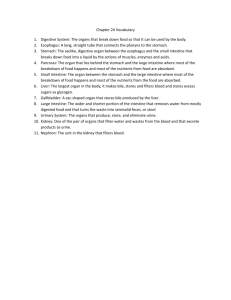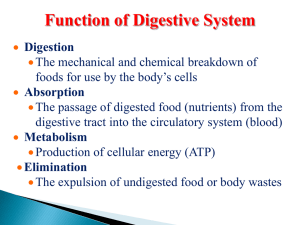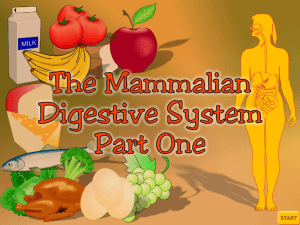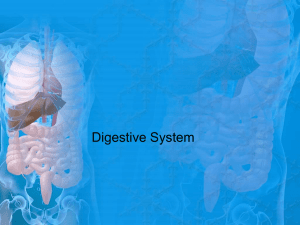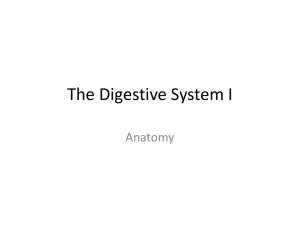Key Questions for Understanding the Organs of the Digestive System
advertisement
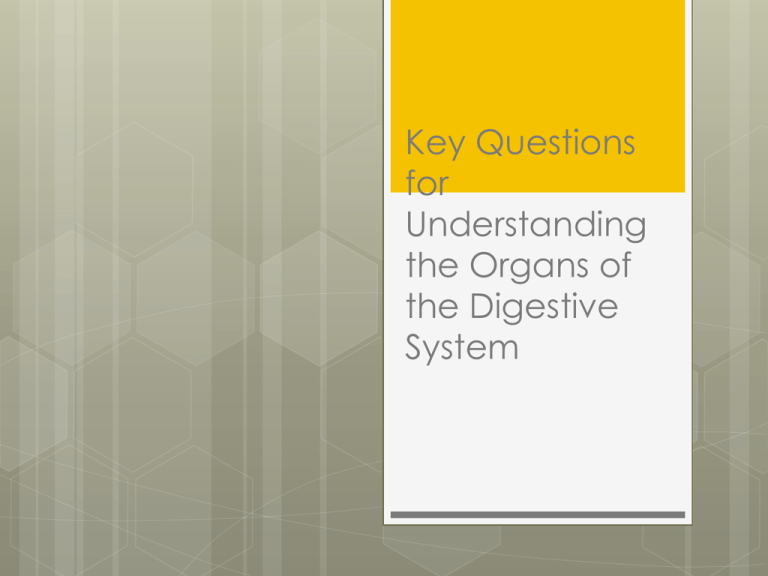
Key Questions for Understanding the Organs of the Digestive System 1. What are the 2 groupings of the digestive organs? The alimentary canal The accessory digestive organs 2. What are the functions of the alimentary canal? It ingests and digests food, absorbs nutrients, and defecates wastes 3. What is the descriptive definition of the alimentary canal? It is a continuous, coiled, hollow, muscular tube that winds through the ventral body cavity and is open at both ends. 4. List the organs of the alimentary canal Mouth pharynx esophagus stomach small intestine large intestine 5. To which 2 bones does the tongue attach… The tongue attaches to the hyoid bone and the styloid process of the skull The lingual frenulum secures the tongue to the floor of the mouth and limits its posterior movements 6. Describe the process of mastication that takes place in the mouth Food is mixed with saliva, then the cheeks and closed lips hold it between the teeth. The tongue mixes food with saliva and initiates swallowing. 7. What is the location, length, and function of the esophagus? It runs from the pharynx to the stomach It is about 10 inches long It is essentially a passageway that conducts food to the stomach 8. Name and briefly describe the 4 basic tunics… 1. 2. 3. 4. mucosa—innermost layer, mainly epithelium Submucosa—soft connective tissue; contains blood vessels, nerves, and lymph vessels Muscularis externa—made up of a circular and longitudinal layer of smooth muscle Serosa—outermost layer, consists of the peritoneum and mesentary 9. What is the function of the nerve plexuses of the alimentary canal? They help regulate the mobility and secretions of the GI tract organs 10. What is the maximum capacity of the stomach? 4 liters (or 1 gallon) of food 11. Why does the stomach contain a layer of obliquely arranged muscle? It allows the stomach to churn, mix, and pummel the food; physically breaking it down into smaller fragments 12. How is food chemically broken down by the stomach? Gastric juice, which consists of proteindigesting enzymes and hydrochloric acid, is produced by the cells of the stomach walls. 13. What is the function of the mucous neck cells? They produce a sticky alkaline mucus, which clings to the stomach wall and protects it from being damaged by stomach acid and enzymes 14. What is chyme? The processed food product that exits the stomach after being partially digested in the pyloric region. It looks like heavy cream. 15. Name and describe the 3 subdivisions of the small intestine Duodenum—about 10 inches long, first part of the small intestine to receive chyme Jejunum—about 8 feet long, extends from the duodenum to the ileum Ileum—about 12 feet long, connects to the large intestine at the ileocecal valve 16. What is the function of the pyloric sphincter? It controls food movement into the small intestine and prevents too much food from entering it at one time 17. How do pancreatic enzymes and bile enter the small intestine? Pancreatic ducts transfer enzymes from the pancreas into the duodenum Bile ducts transfer bile from the liver 18. What 3 structures increase surface area in the small intestine? Microvilli Villi Circular folds 19. What are the functions of the large intestine? To dry out the indigestible food residue by absorbing water To eliminate residue from the body as feces 20. What is the function of the goblet cells in the large intestine? Goblet cells produce mucus, which acts as a lubricant to ease the passage of feces to the end of the digestive tract





